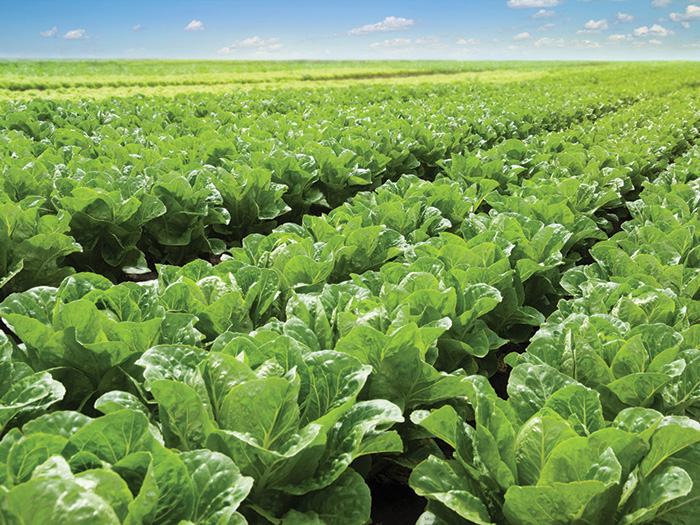From Farm to Table, Here’s How Technology Is Being Used to Push Back Against the Threat of Foodborne Illness

Foodborne illness outbreaks are serious business. An estimated 48 million U.S. residents contract a foodborne illness each year. Of those, approximately 128,000 are hospitalized and about 3,000 will die.
The question inevitably turns to who is responsible. The farmer or producer growing the food? The manufacturer packaging it? The distributor getting it into stores and consumers’ hands?
“There are many places in the food supply chain where contamination could occur,” said Bernie Steves, global specialty products leader, crisis management at Aon, noting that it could start as early as a water contaminant in the growing process all the way to a contamination of product as its being stored at the grocers.
Traceability, therefore, is key.
“One of the big initiatives the FDA has really undertaken is looking at what are better ways to trace the food products through the entire supply chain,” said Lance Reeve, senior risk management consultant for food safety, Nationwide.
“Traceability is important because the quicker we can identify where’s the problem, what the food or what the ingredient is, the quicker we can identify where it came from, get it out of the marketplace and out of the food supply chain.”
Technology has become a valuable tool for those in agribusiness looking to not only trace back the source of a contaminant but also prevent illness from spreading in the first place. They’ve become a risk management dream for the industry.
Here’s a closer look at the tech available today and how it’s being utilized to make the food supply chain safer for consumers.
Sensors in the Field
Crop cultivation has its own fair share of risk, but one technology farmers, or producers, can invest in is food sensors.

Lance Reeve, senior risk management consultant for food safety, Nationwide
“Food sensors have greatly improved” in recent years,” said Al Maxwell, partner at Weinberg Wheeler Hudgins Gunn & Dial. “They’ve become a great means for microbial identification, measuring things like oxygen, pH levels, temperature.”
Maxwell has been in the business for more than 20 years and leads his firm’s foodborne illness practice group. He said, at least on the product side, the category of food being recalled due to illness has shifted from that of beef products, namely ground beef, to more of the leafy green produce, like lettuce, spinach and kale.
“Beef products had an uptick in outbreaks in the early 2000s,” he explained. This prompted regulators to step in and, in conjunction with the industry, create more internal inspection policies, particularly within the manufacturing side of things, to keep beef as safe as possible for the consumer.
What makes the leafy green family a hot contender for contaminants is in its growing habits. Low to the ground, irrigated often by river or canal water, these veggies are more susceptible to E. coli, Listeria and other bacteria that grow in water and soil.
That, and the fact that leafy greens aren’t as heavily manufactured make them ripe for mishap.
“A host of potential environmental factors leading to field contamination puts leafy greens at a much greater risk than the procedures surrounding meat handling,” Maxwell said.
But sensors have the capability to alert producers to potential issues in real-time, enabling them to act before a product even leaves the field. Biosensors are also being utilized to monitor livestock. These tools, while still on the uptake, monitor the health and wellness of an animal and alert to any injury or illness.
Sensors During Shipping
Sensors are being used beyond the fields during the manufacturing and distribution stages of the food supply chain as well.
The devices are embedded into the labels on food packaging in order to detect things like temperature, humidity, presence of pathogens — all areas that could lead to an outbreak of foodborne illness.
“We’re seeing this more so in trucking and cargo,” explained Tami Griffin, national practice leader for Aon’s food system, agribusiness and beverage group. Though, Griffin added, she sees this type of sensor picking up traction for products lining the supermarket shelves.
“COVID drove this technology into play partly because of the lack of labor,” she said. It can be an added safety check where there are fewer human eyes on a product.
Blockchain Adoption Increasing
In a nutshell, blockchain is a public ledger system that acts as a database to store information digitally. Originally designed to manage cryptocurrency systems, blockchains are being used in other industries, including food and beverage.
The information stored in a blockchain can include items such as type of product grown, where it was grown, water amounts used at that site and so on. Though a relatively new technology add for agribusiness, it has the capability to link an outbreak to its source in a matter of minutes instead of days or even weeks.
“It’s a step-by-step ledger that enables accurate tracking of that product from the field all the way to the end consumer,” explained Todd Lalley, technical director, Rick Control, Liberty Mutual. “If you had a recall event, you know exactly where that product is in the process due to this ledger.”
“Large companies and both manufacturers and retailers have really taken a close look at blockchain,” Nationwide’s Reeve said. The biggest example to date, he added, is Wal-Mart, which introduced blockchain technologies for its leafy green produce back in 2017. “Wal-Mart wanted to go out there and see, okay, how can we increase our traceability and reduce the amount of time it takes to track things.”
However, Wal-Mart seems to be an outlier for the time being. Blockchain, while a valuable tech tool, is still considered an emerging technology for the food and beverage space.
Yet arguably it’s an easy one to adopt.
“It’s a fairly simple [risk mitigation] technology, because we’re already in the habit of adding a code or a label on everything that gets shipped,” Lalley said. In that vein, if there’s already a barcode on the product, adding in code to attach the product to its blockchain ledger is a seamless next step.
Blockchain also aids in traceability efforts, especially if a product becomes linked to an outbreak. It enables those in the food supply chain to scan an item and pull it from the shelves before it even gets into the hands of customers.
“The quicker and the faster you can capture that and get it back or get it pulled from the shelves is of high importance,” Lalley said.
Genome Sequencing
Genome or DNA sequencing may sound something of science fiction, but it’s very much in use today.
As noted, traceability is key, and a clear way to trace back an outbreak to its source is by breaking down the genetic code of a product and alerting the producer of the contaminant in their produce. The Centers for Disease Control and Prevention gather data on outbreaks and use the information to find the source.
As Aon’s Steves explained, the CDC is able to review the microorganism making people sick and “use the genome fingerprint of the pathogen and pinpoint the commonalities like a restaurant, grocer, shipment, farm,” and so on.
The CDC then alerts the restaurant, grocer or producer of the outbreak, and product is pulled from the shelves to prevent a wider spread.
The average recall can cost a company upwards of $10 million in direct costs, according to research from Food Safety Magazine, which includes pulling product, brand damage and lost sales. Genome sequencing, on the other hand, can cost as little as $1,000, Sequencing.com reports.
“The process becomes effective, and it becomes repeatable,” explained Lalley. “It’s an emerging technology, too, but I would suspect that as this gets to be more commonplace and becomes more effective, that the cost will get driven down even more.”
Tech on the Manufacturer Side
When it comes to preventing the spread of foodborne illnesses, there are a handful of technologies that food manufacturers in particular are relying on.

Todd Lalley, technical director, Rick Control, Liberty Mutual
High-pressure processing is one. Reeve said packaged food is placed in a large chamber filled with water that is then pressurized.
“What they’re doing is destroying any of the microorganisms or the pathogens that may be within that food product,” he said, both making the food safer and even extending the shelf-life of that product.
Metal detection is another tech used regularly, especially on the food processing side. Metal detectors are able to catch foreign objects that may accidentally make their way onto the conveyor belt or mixing vats. Foreign objects/contaminants are often the leading cause of food recalls.
X-ray technology is also helping to identify foreign objects and removing them before product hits the shelves.
“One of the other technologies used is optical sorters or laser sorters,” Reeve said. “And this is a big advantage. It has a capability to detect and recognize objects’ color, size, shape and structural properties. Often these are used in conjunction with metal detection and/or x-ray machines on a production line to help reduce most all foreign material concerns.”
Not only that, the optical sorters can detect if a single piece of product is starting to go bad. For example, if one pea in the pod is starting to brown, the optical sorters can send an air blast and remove the potentially harmful produce.
“A lot of the seed, nuts, grains, peanuts, fruits and veggies manufacturers are starting to use that,” Reeve said.
Picking the Right Risk Mitigation Strategy
Whatever the tech of choice may be, “picking the right mitigation strategy will vary for each type of business,” Aon’s Griffin said. It will depend on risk appetite, cost standpoint, whether or not public information is available to see where the biggest risks lie in a supply chain, and many other factors.
Still, there are steps to take to keep those in the food supply chain, from producer to distributor, low on the risk spectrum. Following global food safety standards, getting the right ISO certifications, having preventative third parties reviewing cleaning protocols and more are just a few ways to start.
“All those different types of strategies mitigate and reduce [the producer’s] risk as well as improve their viability in the market,” said Lalley. Partnering with a risk control group can be a big add to risk mitigation as well, he added. “We have the ability to look back and say, okay, we’ve seen a number of claims in this industry from a risk control standpoint, as an aggregate across the industry, which enables us to speak to customers about their controls and any potential issues they should mitigate for.”
And, finally, insurance acts as the biggest risk transfer tool.
“Insurance provides protection for any illness, bodily injury, property damage your product could create,” said Steves.
First line of defense is product liability, but as Steves noted, “most product liability policies will exclude product recall.” That’s where product recall policies can be a saving grace. “The trigger for product recall is similar to product liability, however covered losses are quite different,” he said.
Where product liability addresses potential bodily injury and property damage losses, a product recall policy is designed to address recall expenses, as well as the less tangible items, like business interruption and extra expense. “These are frequently the largest areas of losses as it involves your reputation. The public will stop buying a product until they know that first, the contaminated product is off the shelves and second, the company can guarantee the issue is no longer an issue.”
Another area where carriers can shine is in consulting programs. “Carriers have consulting experts available 24/7 to help insureds manage a recall in real time,” Steves said. These consultants are also often available pre-incident to review producers’ plans and help with vendor/supplier audits.
“The consulting aspect, I think, is the most underappreciated part of these policies,” Steves said. “But it’s a great tool for the insured’s risk management efforts.” &










